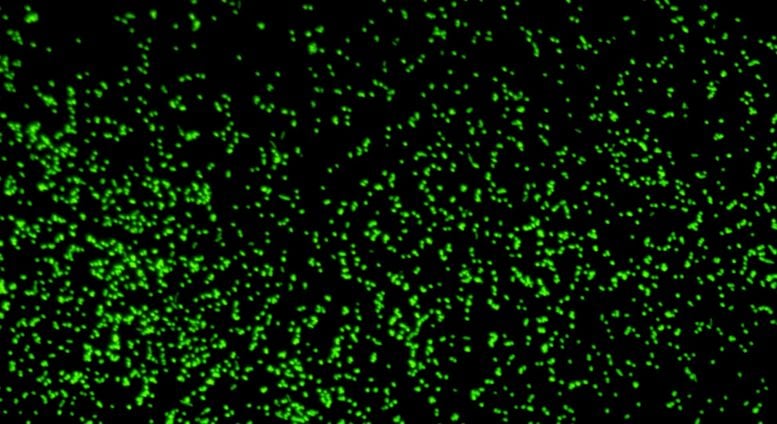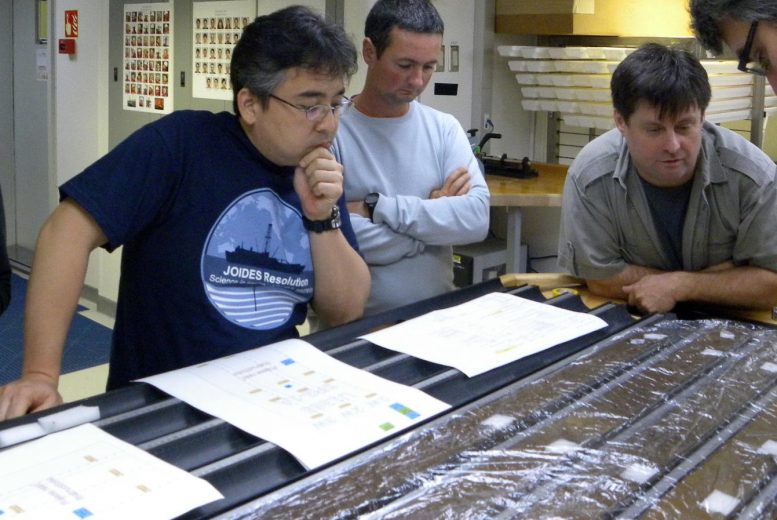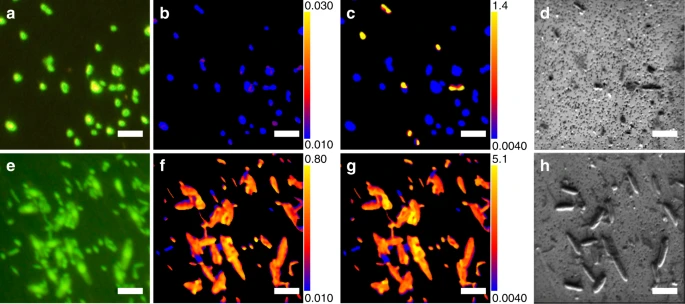
Posted on 07/28/2020 1:05:03 PM PDT by Red Badger

Magnified image showing microbes revived from 101.5 million-year-old sediment. Credit: JAMSTEC
=======================================================================
For decades, scientists have gathered ancient sediment samples from below the seafloor to better understand past climates, plate tectonics, and the deep marine ecosystem. In a new study published in Nature Communications, researchers reveal that given the right food in the right laboratory conditions, microbes collected from sediment as old as 100 million years can revive and multiply, even after laying dormant since large dinosaurs prowled the planet.
The research team behind the new study, from the Japan Agency for Marine-Earth Science and Technology (JAMSTEC), the URI Graduate School of Oceanography, the National Institute of Advanced Industrial Science and Technology, the Kochi University and Marine Works Japan, gathered the ancient sediment samples ten years ago during an expedition to the South Pacific Gyre, the part of the ocean with the lowest productivity and fewest nutrients available to fuel the marine food web.
“Our main question was whether life could exist in such a nutrient-limited environment or if this was a lifeless zone,” said the paper’s lead author Yuki Morono, senior scientist at JAMSTEC. “And we wanted to know how long the microbes could sustain their life in a near-absence of food.”
On the seafloor, there are layers of sediment consisting of marine snow (organic debris continually sourced from the sea surface), dust, and particles carried by the wind and ocean currents. Small life forms such as microbes become trapped in this sediment.

Yuki Morono (left) and Steven D’Hondt (far right) aboard the research drillship JOIDES Resolution with sediment cores gathered from the South Pacific Gyre. Credit: Photo courtesy of IODP JRSO
==========================================================================
Aboard the research drillship JOIDES Resolution, the team drilled numerous sediment cores 100 meters below the seafloor and nearly 6,000 meters below the ocean’s surface. The scientists found that oxygen was present in all of the cores, suggesting that if sediment accumulates slowly on the seafloor at a rate of no more than a meter or two every million years, oxygen will penetrate all the way from the seafloor to the basement. Such conditions make it possible for aerobic microorganisms–those that require oxygen to live–to survive for geological time scales of millions of years.
With fine-tuned laboratory procedures, the scientists, led by Morono, incubated the samples to coax their microbes to grow. The results demonstrated that rather than being fossilized remains of life, the microbes in the sediment had survived, and were capable of growing and dividing.
“We knew that there was life in deep sediment near the continents where there’s a lot of buried organic matter,” said URI Graduate School of Oceanography professor and co-author of the study Steven D’Hondt. “But what we found was that life extends in the deep ocean from the seafloor all the way to the underlying rocky basement.”
Morono was initially taken aback by the results. “At first I was skeptical, but we found that up to 99.1% of the microbes in sediment deposited 101.5 million years ago were still alive and were ready to eat,” he said.
With the newly developed ability to grow, manipulate and characterize ancient microorganisms, the research team is looking forward to applying a similar approach to other questions about the geological past. According to Morono, life for microbes in the subseafloor is very slow compared to life above it, and so the evolutionary speed of these microbes will be slower. “We want to understand how or if these ancient microbes evolved,” he said. “This study shows that the subseafloor is an excellent location to explore the limits of life on Earth.”
Before looking ahead to future research, D’Hondt took time to reflect on Morono’s achievement. “What’s most exciting about this study is that it shows that there are no limits to life in the old sediment of the world’s ocean,” said D’Hondt. “In the oldest sediment we’ve drilled, with the least amount of food, there are still living organisms, and they can wake up, grow and multiply.”
Reference: 28 July 2020, Nature Communications. DOI: 10.1038/s41467-020-17330-1
This study was supported by the Japan Society for the Promotion of Science (JSPS), the Funding Program for Next Generation World-Leading Researchers, and the U.S. National Science Foundation. This study was conducted using core samples collected during Expedition 329, “South Pacific Gyre Subseafloor Life,” of the Integrated Ocean Drilling Program.
Jurassic Park, The Thing, yeah, the good ones..............
If you find these scientists please contact....
 Fig. 1: 13C and 15N incorporation in representative microbial cells. figure1 Cells from incubations of U1365 9H-3 with 13C-bicarbonate and 15N ammonium (a–d) and 13C,15N-Amino acid mix (e–h). (a, e) SYBR Green I-stained cells under fluorescence microscopy. b, c, f, g Ratio images of 13C/12C (b, f) and 12C15N/12C14N ratios (c, g) of the same regions imaged in a, e, demonstrating locations of 13C and 15N incorporation. Color-scale ranges of the ratios are shown as numbers appearing at top and bottom of the color bar. The background membrane region, which is identified by fluorescence images, is excluded from the ratio calculation and shown as black background. d, h. Secondary electron (NanoSIMS) images of the same regions in a, e. Bars represent 5 µm. Similar images were processed for obtaining the dataset (Supplementary Data 1) of substrate incorporations for 6986 individual cells.
Fig. 1: 13C and 15N incorporation in representative microbial cells. figure1 Cells from incubations of U1365 9H-3 with 13C-bicarbonate and 15N ammonium (a–d) and 13C,15N-Amino acid mix (e–h). (a, e) SYBR Green I-stained cells under fluorescence microscopy. b, c, f, g Ratio images of 13C/12C (b, f) and 12C15N/12C14N ratios (c, g) of the same regions imaged in a, e, demonstrating locations of 13C and 15N incorporation. Color-scale ranges of the ratios are shown as numbers appearing at top and bottom of the color bar. The background membrane region, which is identified by fluorescence images, is excluded from the ratio calculation and shown as black background. d, h. Secondary electron (NanoSIMS) images of the same regions in a, e. Bars represent 5 µm. Similar images were processed for obtaining the dataset (Supplementary Data 1) of substrate incorporations for 6986 individual cells.
Why did we evolve?
Below the bottom?
I swear these guys don’t watch movies at all...
Yes, from drilling cores into the muck...................
The Thing. It did not end well.
Have a container of bleach handy, just in case.
Now is the chance for evolutionary biologists to show how good they are and predict what features will be seen in the genome sequence based on their evolutionary theories.
Thanks Red Badger. Microbes, yourcrobes, everybodyscrobes.
Were samples sent to the Wuhan Institute of Virology?
so since it is 2020 and everything else is decimated, why not add some foreign microbe to the mix... what could go wrong!
That struck me as one of the best replies I've ever seen on FR to an article about scientists reviving ancient bacteria. You've articulated what I've always thought when I read an article like this.
COVID-100MillionB.C. ?
Whelp, since we have no absolute accurate method or dating....by what standard are they stating 100 million? Why not 1? Why not 20K?
Radiocarbon dating THEORY only works if the atmospheric pressure has remained constant, and the ratio of Carbon (C) 12 levels to C14 are the same. That is not the case.
“Isn’t this how a sci-fi/horror novel begins?...”
No. Nine movies out of ten there’s a couple making out in some remote area. The woman says, “What’s that?” And the guy says, “It’s nothing.”
The tenth movie starts in some remote area with somebody dying horribly, then it goes to the couple making out.
BTW, from now on, the couple making out will be two of the same sex, or two people of different races. At which point the woman will say, “What’s that?” The partner will say, “Who give a f#ck?”
Disclaimer: Opinions posted on Free Republic are those of the individual posters and do not necessarily represent the opinion of Free Republic or its management. All materials posted herein are protected by copyright law and the exemption for fair use of copyrighted works.